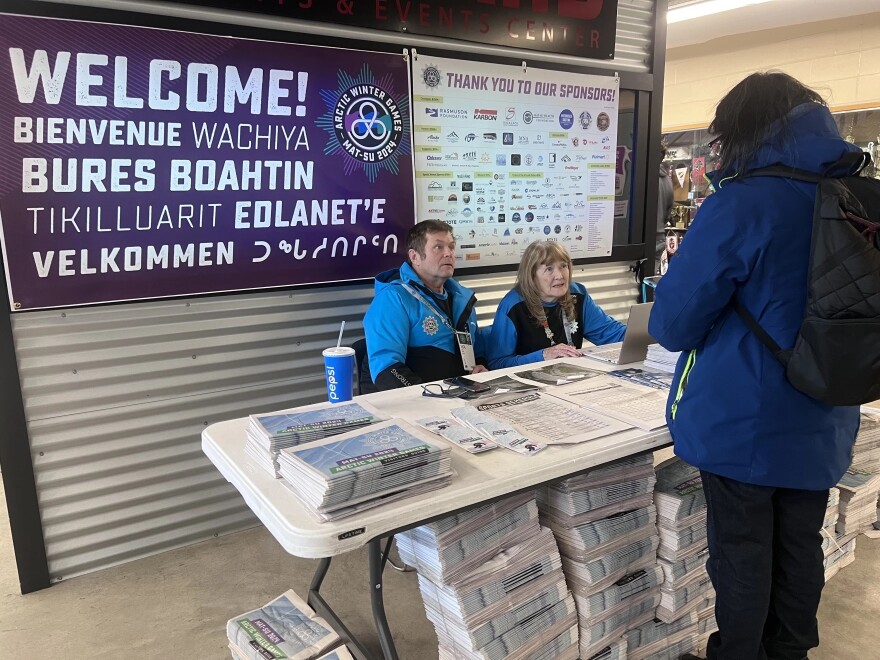After a week of competition hosted by the Matanuska-Susitna Borough, more than 1,700 athletes in the Arctic Winter Games are headed home.
The teams hailed from six Arctic nations: Canada, Greenland, Norway, Sweden, Finland and the United States, which is represented by Alaska — each out to collect the most ulus, medals that are shaped like a curved Inuit knife.
Alaska, with its home-team advantage, took home the most ulus — 221, including 70 gold. Team Yukon came in second in the overall medal count and was also the winner of the coveted Hogsdon award — a seven-foot-high trophy, hand-carved from a narwhal tusk, with a bear that clings to the top. It honors the team that best exemplifies the values of the Arctic Winter Games: team spirit, cooperation and fair play.
(Click here to see a listing of the medals and final standings. And click here for more Arctic Winter Game highlights. )
Some call the Arctic Winter Games the Olympics of the North, because it features all of the traditional winter sports like skating and skiing, but also futsal, a form of indoor soccer, as well as gymnastics and table tennis. But the Dene Games and Indigenous Arctic sports, better known in Alaska as the Native Youth Olympics, are what make this a one-of-a-kind event.
During the Dene Games, chanting and cheering can be heard in several different Indigenous languages.
Majorie Tahbone says it’s exciting to hear and creates a space that is welcoming to Indigenous people.
Tahbone, who is from Nome, has been involved in the Dene Games for 20 years. Today, she coaches students.
“It warms my heart,” she said. “Just being able to come together with international friends and cousins has been so motivating.”
“It’s very emotional,” said Judah Eason, an Unangax̂ from Kenai.
Eason won a bronze ulu in the adult male, finger pull competition, which was traditionally used to strengthen hands and fingers for the fishing season.
Eason said he was even more excited when elders presented him with the Fair Play award.
“That’s the heart of these games, more than anything else, the ability to mentor others and win and lose graciously and build each other up as a community,” said Eason, who currently teaches singing, dancing and drumming for the Kenaitze Tribe.
Not far from where the Dene Games were being played in the Curt Menard Sports Arena, sat Jack and Kathy Timm, among 2,000 volunteers for the Arctic Winter Games.
The Wasilla couple said given that so many people were involved in carrying off these games, they expected a lot of glitches, but the Timms say they’re surprised at how this mega-event ran like a well-oiled machine.
“There’s so much positivity just flowing through this building,” Kathy Timms said.
For husband, Jack, the games bring back a lot of memories. In the 1980 Arctic Winter Games, he won a silver medal in cross-country skiing for Team Alaska.
“The kids are exactly the way I remember when I was in the games in 1980,” Timm said. “They’re here to do a job.”
He says it was very impressive to see so many of the male hockey players from other Arctic nations dressed up in suits and ties when they weren’t in uniform, a sign of how important this event is to them.
Such was the case for Team Nunavut, which represents Canada’s largest and northernmost territory.
Just after they won a bronze medal in their semi-final game against Team Yukon, they boarded a bus dressed in suits.
They were hoping to do better, but Luke Joy, one of their teammates, says it wasn’t a total loss.
“We all came together as a team, and we all started communicating together,” Joy said. “And we just found our inner peace.”
Luke’s father, Martin, coaches the team. He says young people across the Arctic have to deal with a lot of isolation, but the inclusiveness and the diversity of the games is an important part of the experience.
“It just shows the kids that we’re not much different than anybody else, but just how resilient we are,” said Joy, who believes it’s important to celebrate success when it happens.
“Go Blue. Go Blue,” shouted Crystal Loutitt, a hoarse hockey mom from Northwest Territories. She waved a big NWT flag, as her son’s team faced off against Team Alaska.
She said the NWT team was definitely the underdog.
“We don’t get a lot of chances to play competitive sports, because we’re pretty isolated,” Loutitt said. “The nearest town is two-and-a-half to three hours away. To be able to come here and compete is an amazing experience for the boys for sure.”
Ultimately Team Northwest Territories had to settle for a silver ulu, after Team Alaska shut them down in an 8-to-1 victory.
But two years from now, there will be a chance for a rematch.
Planning is already underway for the next Arctic Winter Games, to be held in Whitehorse in 2026.
The late Alaska governor Wally Hickel and other Arctic nation leaders founded the games in 1959 to bring circumpolar peoples together, to celebrate life in the North and build bonds to will bring the peoples of the Arctic closer together.
Organizers of the 2024 games estimate that in addition to the athletes and volunteers, the event brought 4,000 visitors to the Mat-Su with an economic impact of about $10 million.
The visitors from Nunavut kept raving about the mountains in Wasilla and Palmer, a memory they’ll take back home, along with new friendships and experiences they say will last a lifetime.






